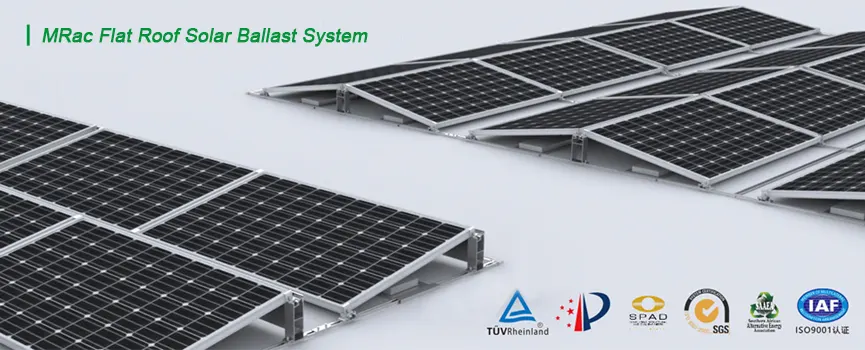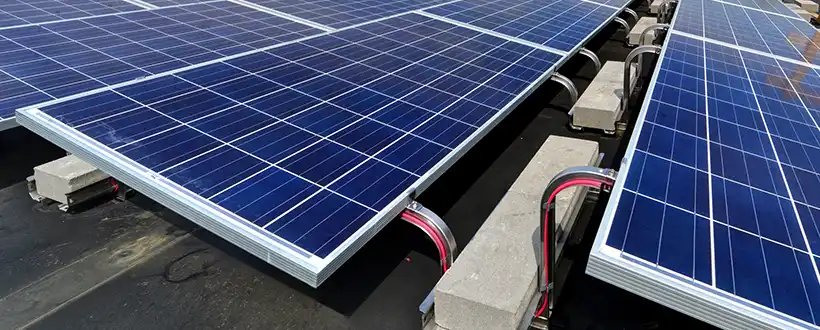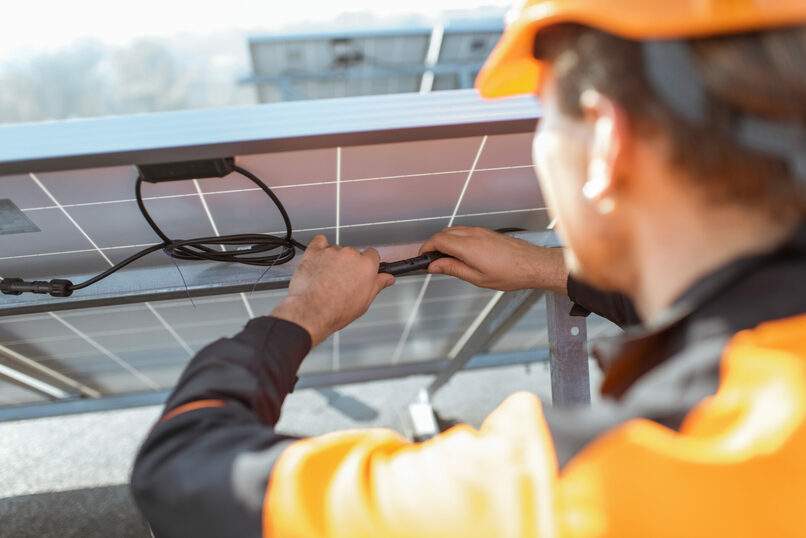
What Is a Flat Roof Solar Ballast System?
2023-12-18Solar energy is a wise choice for homes and businesses with various roof types, including flat roofs. However, there are a few considerations to keep in mind when installing solar panels on a flat roof. This guide will provide you with an overview of flat roof solar ballast systems and how they can enhance the efficiency of your solar system compared to traditional ones.
What Is a Flat Roof Solar Ballast System?
A ballasted system is a type of flat roof solar mounting system, commonly used on roofs with minimal or no slope. This racking system is frequently employed in larger commercial projects where property owners prefer to minimize roof penetrations while installing solar panels. In a ballasted racking system concrete blocks are placed in the system in order to weigh down the solar array and prevent the panels from being affected by weather elements like wind or snow. Flat roofs are well-suited for solar installation due to their ease of system assembly and straightforward access.
How are Ballast Mounted Solar Systems Installed?
Ballast systems differ from traditional roof mounts as they use weights to achieve stability instead of attaching directly to the building's roof beams through penetrations. These mounts are part of a solar racking system that connects to solar panels, where trays positioned beneath the panels hold heavy concrete blocks, providing the necessary mass to secure the panels on flat roofs firmly.
For those with limited roof space who require a significant amount of electricity, maximizing solar panel density is key. This is often achieved by setting the panels at a shallow angle, about ten degrees or less, allowing for tighter spacing of panel rows without causing one to cast a shadow over the next. Such a minimal tilt also facilitates the shedding of rain and snow, preventing accumulation.
Conversely, if your roof offers ample space for your energy production goals, you might consider steeper panel angles. While this necessitates wider spacing between rows due to longer shadows, it can also enhance energy capture, especially in certain geographic locations.
Ideally, solar panels are most efficient when angled in correspondence with the latitude of the site—panels at a 30-degree angle along the 30-degree latitude, for instance. At the equator, panels would be installed horizontally. While the optimal tilt improves performance, it isn't crucial for a solar system to function effectively.

Involvement of Professional Engineers Is Important
Solar ballast arrays on flat roofs
When it comes to solar panel installations, particularly those involving ballasted systems, the involvement of professional engineers is crucial. A professional engineer (P.E.) possesses the necessary expertise to evaluate various factors that influence the design and implementation of a ballasted solar system. They can effectively assess the size of the system, its orientation, the prevailing climate conditions, the roof load, and the strength of the racking equipment. This comprehensive evaluation ensures that the appropriate ballasts are selected to securely anchor the solar panels and withstand the forces of wind and snow.
Before signing off on a solar installation contract, it's essential to inquire about the installer's involvement with professional engineers. Ideally, the installer should have a P.E. on their team or collaborate with a consulting P.E. during the design phase. The P.E.'s expertise will ensure that the ballasted system is designed and installed in accordance with industry standards and safety regulations.
Advantages of Flat Roof Solar Ballast Systems
Ballasted solar arrays utilize the weight of rocks or concrete blocks to counter the forces of wind uplift and seismic shaking. These systems typically feature a grid-like structure of interconnected rows and columns, allowing for the partial transfer of point loads from one module to multiple neighboring components. This distribution of forces reduces the ballast weight required for individual parts of the array. Consequently, ballasted systems are best suited for large PV installations with high load transference capabilities.
A primary advantage of ballasted solar arrays is their ability to be installed without penetrating the roof. This eliminates the need for roofing contractor services to seal penetrations, simplifying the installation process. Indeed, some ballasted systems are ready for assembly upon unpacking, significantly reducing project timelines.
Additionally, the use of ballast on flat-roof solar installations can enhance the system's aesthetics. Strategically placed ballast can create a uniform and streamlined appearance, particularly when the flat roof is visible from the first floor or neighboring buildings. By carefully selecting and positioning the ballast, the solar system can become an aesthetically pleasing element that complements the building's architecture. This approach preserves the building's aesthetics while contributing to a positive perception of solar energy as a modern and environmentally friendly energy solution.
The Mibet flat roof mounting system is available in two configurations: horizontal south and east-west. It's aerodynamic and has been ballasted optimized through additional wind tunnel testing. Please visit this page to learn more.
A Few Things To Consider
Mibet China Flat Roof Ballast System Project
Roof Support Requirements for Ballast Mount Systems
Ballasted solar systems rely on weight to remain in place, so the roof and building structure must be able to support this additional load. While most commercial roofs in good condition can accommodate the weight of an average 60-cell solar panel, which typically weighs around 40 pounds, a third-party structural engineer must review and approve the installation plan before proceeding.
Impact of Strong Winds on Ballast Requirements
Ballast mount systems are designed to withstand strong winds, but the amount of ballast required increases with wind intensity. This is particularly relevant for buildings located several stories above ground level or in coastal areas where winds are typically stronger. Additional ballast may be necessary to ensure the system's stability in these locations.
Roof Condition Assessment for Solar Panel Installation
As with any roof-mounted solar system, it is crucial to ensure that the roof is in good condition before installing panels. Panels should only be mounted on roofs that are at an early stage of their lifespan and can support the weight of the panels for several decades. Generally, installing solar panels on roofs with a shorter remaining lifespan than the payback period of the panels is discouraged. For instance, if the payback period for the solar system is 10 years, it is advisable to avoid mounting panels on a roof with only 7 years of useful life remaining, as the cost of removing and reinstalling the panels can be significant.
Compatibility of Ballast Mounts with Flat Roofs
While most flat roofs have a slight pitch of under ten degrees to aid water drainage, ballast mounts are generally suitable for roofs with a pitch of three degrees or lower. However, steeper roofs may require additional ballast to maintain stability, which could potentially exceed the roof's weight-bearing capacity.
Maximizing Solar Energy Production on Pitched and Flat Roofs
Solar panel system design for pitched roofs requires careful consideration of roof angle and orientation to optimize energy production. Ideally, panels should face south and be tilted at an angle equal to the building's latitude. However, east- or west-facing roofs or limited installation space on the north side may result in reduced daily electricity generation. Additionally, steeper sloped roofs may not provide the ideal angle for maximum energy capture. While these factors can affect energy output, solar panels can still be a worthwhile investment.
Flat roofs offer greater flexibility in solar panel system design. Panels can be oriented directly south and mounted at the optimal angle to maximize energy production, often outperforming systems on sloped roofs. This flexibility allows homeowners to harness the full potential of solar energy even when roof orientation or slope is less than ideal.
Frequently Asked Questions

How heavy are solar panels on roof?
The weight of solar panels varies depending on the manufacturer and type. Standard 60-cell residential solar panels typically weigh around 40 pounds, while commercial solar panels may weigh closer to 50 pounds. In addition to the panel itself, the frame and mounting equipment contribute to the overall weight. These components typically weigh around the same amount for both residential and commercial panels.
How much ballast do I need for solar panels?
Ballast weight requirements for solar panels depend on various factors, including wind speed, roof angle, and panel layout. For instance, with a wind speed of 150 kilometers per hour and a roof angle of 15 degrees, the minimum ballast weight needed is approximately 85 kilograms per square meter.
What is the purpose of ballast in a flat roof racking system?
In a ballasted racking system, concrete blocks are strategically placed to weigh down the solar array and secure the panels against adverse weather conditions, such as high winds and heavy snow loads. These blocks provide the necessary weight to prevent the array from lifting or shifting, ensuring the long-term stability and performance of the solar system.
